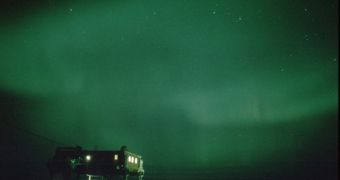In a new investigation, scientists have finally been able to determine precisely what is it that creates the peculiar faint glow that lies above Earth atmosphere, called the diffuse aurora.
At latitudes where auroras are visible, the atmosphere also shows signs of residual light, and the origin of this phenomenon has thus far been clouded in mystery.
For the new study, investigators turned to analyzing a special type of radio waves called chorus waves, which underlie the development of any aurora that appears at either the North or South Pole.
These radiation are called thus because they sound like the song of birds when played through loudspeakers. When several birds sing the same thing at once, the chorus effect develops.
In previous investigations, physicists and planetary scientists have determined that these special radio waves can also cause the northern and southern lights to pulse.
An added effect is that they create the diffuse glow as well, experts now believe. Details of the new idea are published in the October 21 issue of the esteemed scientific journal Nature.
Apparently, chorus waves are capable of inducing a scattering effect in electrons that reside in the space just above the atmosphere, making the particle head downwards, and create the diffuse glow.
One thing about this residual light is that it is a lot more difficult to see than the conventional lights, called discrete auroras. Whereas the latter appear as clearly-visible curtains of light, the former can be seen with specialized instruments, but cover a wider swath of the sky.
The new investigation was conducted by scientists with the British Antarctic Survey (BAS) in Cambridge, England, who were led by Richard Horne. He is also a coauthor of the new research.
A study published a short while ago provided the irrefutable proof that chorus waves were also responsible for triggering the creation of pulsating aurora, light glows that appear to be pulsating on and off.
Horne says that the two investigations each support the other's conclusions. The new study was carried out using computer models.
The researchers wanted to learn how the radio waves lurking in the atmosphere would scatter incoming electrons. They also wanted to find out how many of the particles would remain trapped in the planet's magnetic field
“The real clincher was when we examined the distribution of electrons left behind in space which resembled a pancake – very flat and peaked in a direction across the magnetic field direction,” Horne says, quoted by Space.
“Only chorus waves could produce the 'pancake' distribution. [This research] is an important one because it will help scientists to understand how the diffuse aurora leads to changes in the chemistry of the Earth's upper atmosphere, including effects on ozone at high altitude, which may affect temperature right through the atmosphere,” he concludes.

 14 DAY TRIAL //
14 DAY TRIAL //